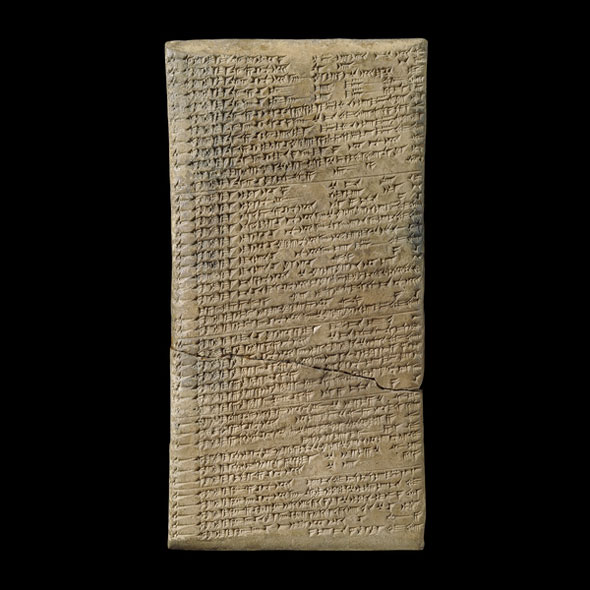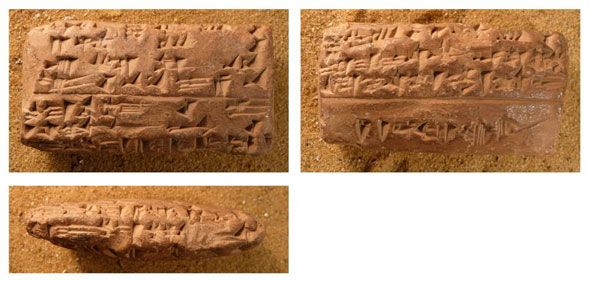A book of ominous births, 650 BC

Translation:
'If a woman gives birth and the baby has lion's ears: there will be a strong king in the land.
If a woman gives birth and the baby has no right ear: the prince's days will end.
If a woman gives birth and the baby has no left ear: the prince's days will be long.
If a woman gives birth and the baby has no ears: there will be distress in the land and the land will be diminished.'
Long before paper, long before books, people pondered the meaning of strange births, both human and animal. Even kings cared about what they portended, as clay tablets from ancient Nineveh show.
In the middle of the 7th century BC, King Assurbanipal was ruler of Assyria, a mighty empire that stretched right across the Middle East, from Turkey to Egypt, from the Mediterranean to western Iran. In Nineveh, his capital city in northern Iraq, he built a library and housed it with scholars to collect and interpret all the world's knowledge. They were also expected to make regular observations of events in the heavens and world around, and to report to the King about what they meant for him and his empire.
Because the Assyrian scholars wrote on clay, not papyrus; and because their enemies, the Medes and the Babylonians, burned down Nineveh in 612 BC; and because a young British adventurer rediscovered the baked tablets in the mid-19th century – because of all those accidents of history, the contents of Assurbanipal's library and his scholars' correspondence now reside in the British Museum, where Assyriologists like me study and translate them.
The clay tablet shown here contains Chapter 3 of a 24-chapter series of omens about strange births. It measures about 17cm high by 8.5cm wide and is around 3cm thick in the middle. On the back (not shown) is a colophon, or sort of library stamp, that states it belongs to king Assurbanipal's library. It is written in cuneiform script with a reed stylus in the literary language of the time, which is now called Standard Babylonian.
The book's Assyrian name was Shumma Izbu, 'If an anomaly', after the first two words of its very first line. It originally contained about 3000 different omens, all about the meanings of strange or unusual births to human or animal mothers. The idea behind Shumma Izbu was already old in 650 BC: there are surviving collections of birth omens on clay tablets that are at least a thousand years older than this one. But what makes Assurbanipal's Shumma Izbu special is that it is organised systematically and exhaustively; and that we know it was really used.
We don't know exactly who edited Shumma Izbu, or even exactly when – perhaps as early as 1100 BC, perhaps as late as 700 BC. But he (or less likely she) grouped the omens according to animal: the first chapters are about humans, then farmed animals such as sheep, goats, cattle, and pigs. The anomalies themselves concern missing, misplaced, or overabundant body parts, as well as strange colours and body parts belonging to other animals.
As the example above shows, the predicted outcomes for king and country are often based on analogies or word-plays with the observed birth phenomena. So the powerful lion implies a strong king, while absence leads to distress and loss. The right side of the body is associated with good, so damage there portends badly, while damage on the evil left bodes well.
Surviving reports show scholars notifying the king of strange births in the land, including an eight-legged piglet, twin calves and foals, conjoined lambs, a hermaphrodite, and – most ominous of all – a lion born to a cow. However, there is one letter, unfortunately very damaged, that explains to the king that Shumma Izbu does not mention every possible strange birth. The gods could bring surprises even to the most well-prepared of scholars.
The wonder of malformed births is still with us, if only as curiosities in the free newspapers given away to city commuters. Assurbanipal's scholars would instantly recognise the significance of the Metro's birth reports of a seven-legged lamb, a six-legged pig, five-legged frogs, and a four-legged duck. Even if we can now explain such events in terms of genetic abnormalities, there remains the disturbing thrill of the familiar gone awry.

Translation:
'If an anomaly has 8 feet and 2 tails: the ruler will seize the kingship of the world. That archer – his name is Tamdanu – says as follows: “When a sow of mine gave birth, (the young) had 8 feet and 2 tails. I pickled it in salt and put it into the house."' (from Nergal-etir)
Eleanor Robson (formerly HPS, Cambridge, now at UCL)
Further reading
Shumma Izbu was edited by the Assyriologist Erle Leichty forty years ago, in a book that is now out of print and available only in specialist academic libraries: E. Leichty, The omen series Šumma Izbu (Texts From Cuneiform Sources 4) (Locust Valley, NY: Augustin, 1969)
But many ancient manuscripts of this work, from all over Assyria and Babylonia, are now being re-edited in the Corpus of Ancient Mesopotamian Scholarship (CAMS)
The website Knowledge and Power in the Neo-Assyrian Empire is all about how King Assurbanipal and his father Esarhaddon used science and scholarship for political ends. It includes a full bibliography and lots of links to relevant ancient texts in English translation. It also contains an extensive section on the cuneiform writing system and the Akkadian language, of which Assyrian and Babylonian were the northern and southern dialects.
